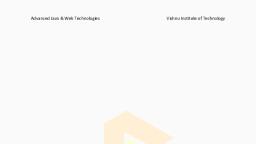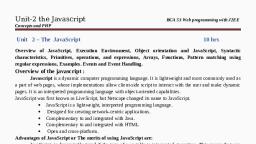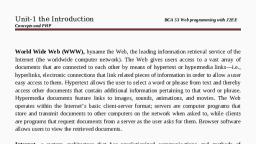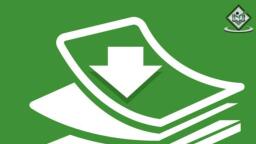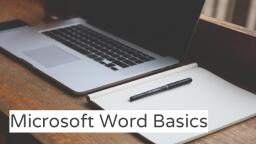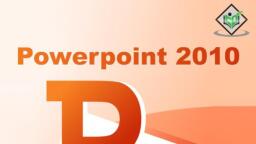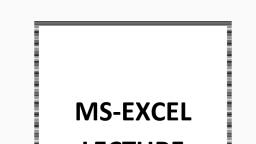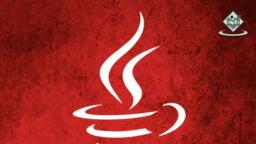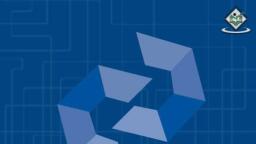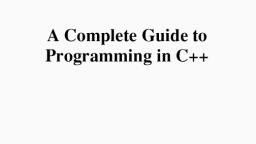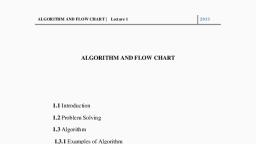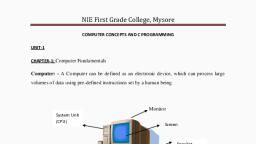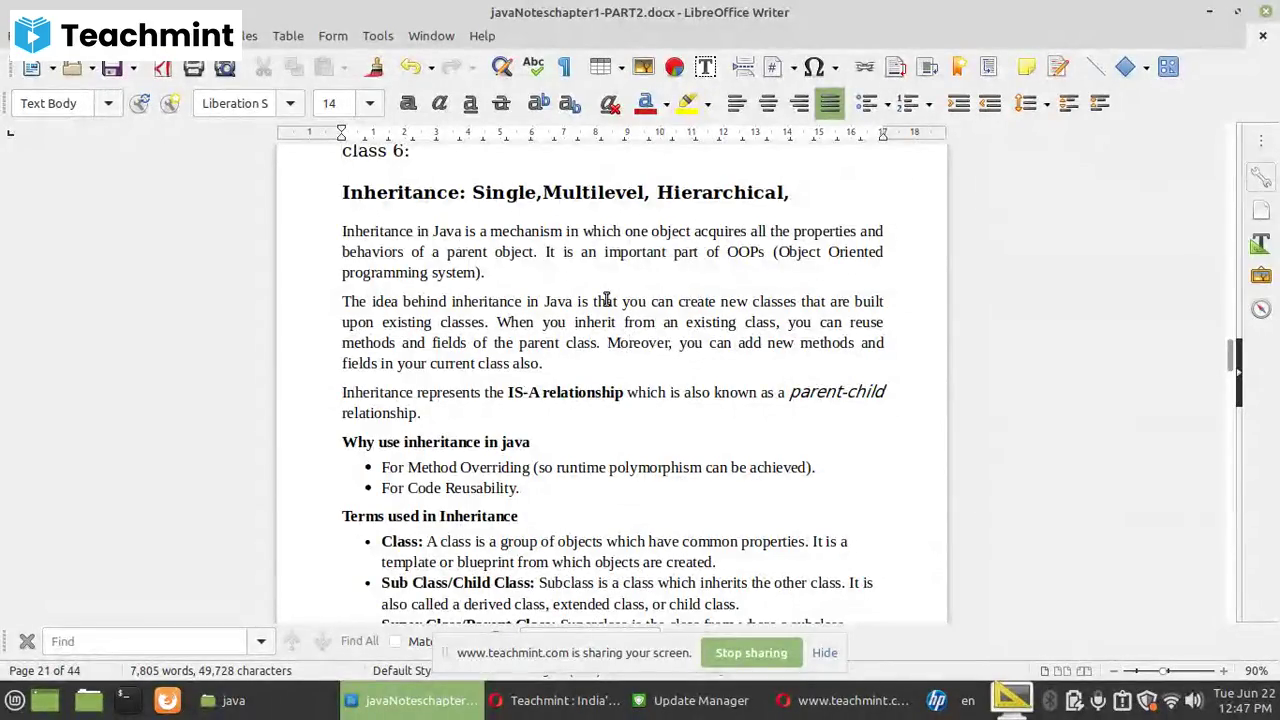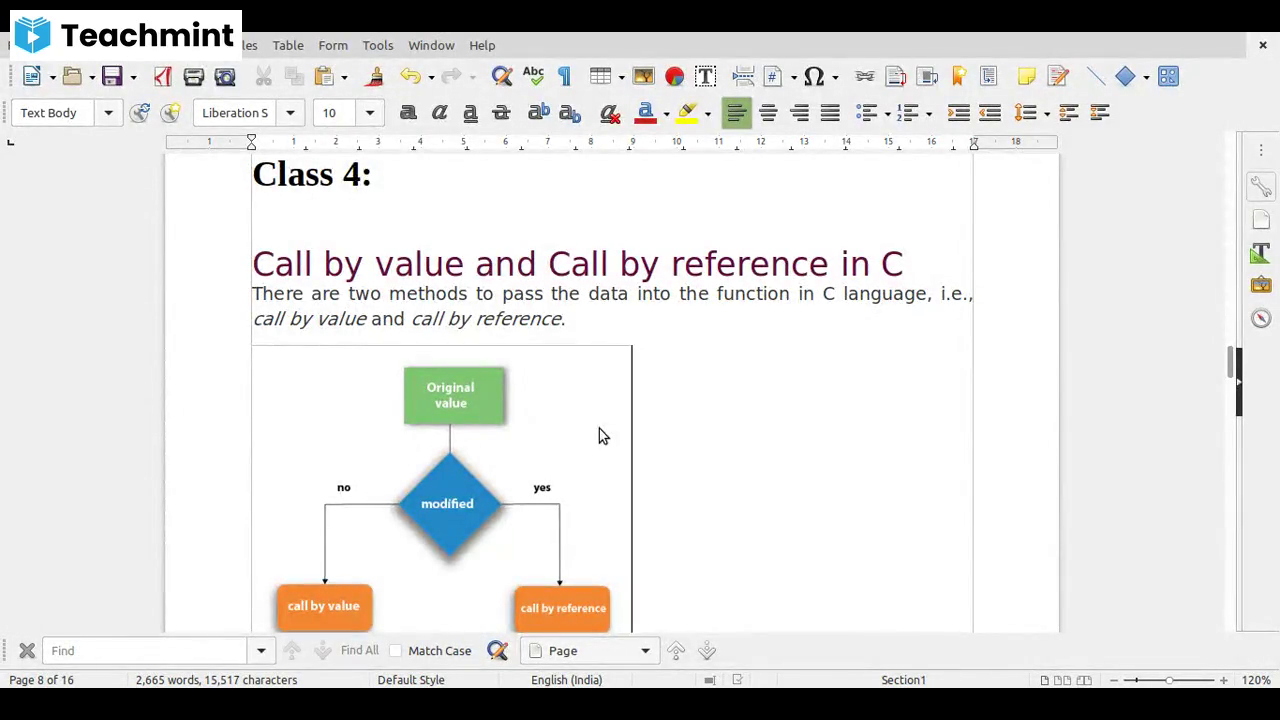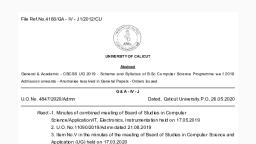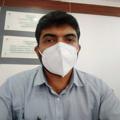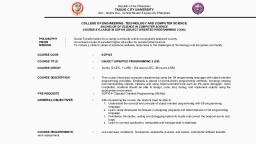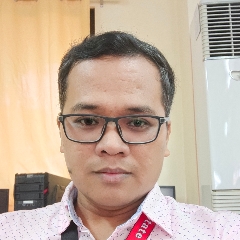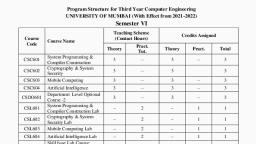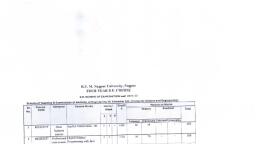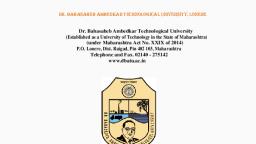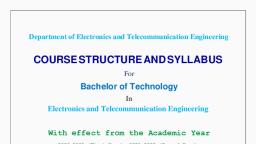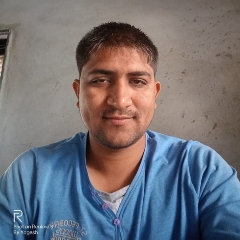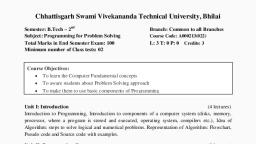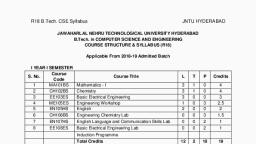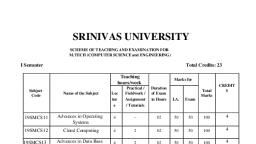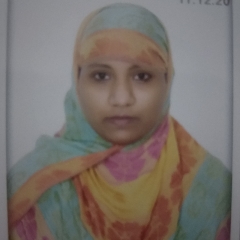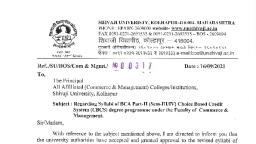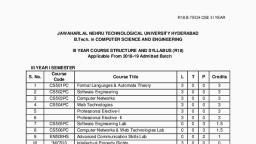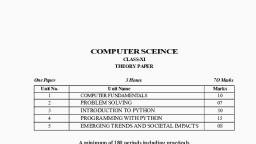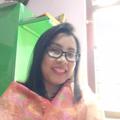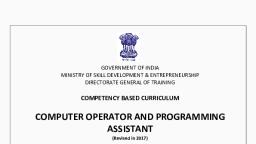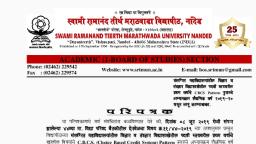Page 1 :
KUVEMPU, , UNIVERSITY, , NEP-2021, , curriculum structure AND SYLLABUS, , Bachelor of Computer Application (Basic and Honors) Programmes, as Major and Minor Courses, And, Open Elective courses in Computer Applications, , w.e.f Academic Year 2021-22 onwards
Page 2 :
The objectives of the BCA Program, 1. The primary objective of this program is to provide a foundation of computing, principles and business practices for effectively using/managing information, systems and enterprise software, 2. It helps students analyze the requirements for system development and exposes, students to business software and information systems, 3. This course provides students with options to specialize in legacy application, software, system software or mobile applications, 4. To produce outstanding IT professionals who can apply the theoretical knowledge, into practice in the real world and develop standalone live projects themselves, 5. To provide opportunity for the study of modern methods of information, processing and its applications., 6. To develop among students the programming techniques and the problemsolving skills through programming, 7. To prepare students who wish to go on to further studies in computer science and, related subjects., 8. To acquaint students to Work effectively with a range of current, standard, Office, Productivity software applications, , 1
Page 3 :
Program Outcomes: BCA (3 Years) Degree, 1. Discipline knowledge: Acquiring knowledge on basics of Computer Science and, ability to apply to design principles in the development of solutions for problems, of varying complexity, 2. Problem Solving: Improved reasoning with strong mathematical ability to, Identify, formulate and analyze problems related to computer science and, exhibiting a sound knowledge on data structures and algorithms., 3. Design and Development of Solutions: Ability to design and development of, algorithmic solutions to real world problems and acquiring a minimum, knowledge on statistics and optimization problems. Establishing excellent skills in, applying various design strategies for solving complex problems., 4. Programming a computer: Exhibiting strong skills required to program a, computer for various issues and problems of day-to-day applications with, thorough knowledge on programming languages of various levels., 5. Application Systems Knowledge: Possessing a sound knowledge on computer, application software and ability to design and develop app for applicative, problems., 6. Modern Tool Usage: Identify, select and use a modern scientific and IT tool or, technique for modeling, prediction, data analysis and solving problems in the area, of Computer Science and making them mobile based application software., 7. Communication: Must have a reasonably good communication knowledge both, in oral and writing., 8. Project Management: Practicing of existing projects and becoming independent, to launch own project by identifying a gap in solutions., 9. Ethics on Profession, Environment and Society: Exhibiting professional ethics, to maintain the integrality in a working environment and also have concern on, societal impacts due to computer-based solutions for problems., 10. Lifelong Learning: Should become an independent learner. So, learn to learn, ability., 11. Motivation to take up Higher Studies: Inspiration to continue educations, towards advanced studies on Computer Science., , 2
Page 4 :
Additional Program Outcomes: BCA Degree (Hons), The Bachelor of Computer Application (BCA (Hons)) program enables students to attain, following additional attributes besides the afore-mentioned attributes, by the time of, graduation:, , 1. Apply standard Software Engineering practices and strategies in real -time software, project development, , 2. Design and develop computer programs/computer -based systems in the areas, related to AI, algorithms, networking, web design, cloud computing, IoT and data, analytics., , 3. Acquaint with the contemporary trends in industrial/research settings and thereby, innovate novel solutions to existing problems, , 4. The ability to apply the knowledge and understanding noted above to the analysis of, a given information handling problem., , 5. The ability to work independently on a substantial software project and as an effective, team member., , 3
Page 5 :
Curriculum for BCA, , Hour / Week, Sem Core Courses, Theory, Lab, 1, 3, i. Fundamentals of Computers, 3, ii. Programming in C, 3, iii. Mathematical, Foundation, 4, iv. LAB: Information Technology, 4, v. LAB: C Programming, 2, i. Discrete Mathematical Structures, 3, 3, ii. Data Structures using C, iii. Object Oriented Concepts using, 3, 4, JAVA, 4, iv. LAB: Data Structure, v. LAB: JAVA Lab, 3, 3, i. Data Base Management Systems, 3, ii. C# and DOT NET Framework, 3, iii. Computer Communication, and Networks, 4, iv. LAB: DBMS, 4, v. LAB: C# and DOT NET Framework, 4, 3, i. Python Programming, 3, ii. Computer Multimedia and, 3, Animation, 4, iii. Operating Systems Concepts, 4, iv. LAB: Multimedia and Animation, v. LAB: Python programming, 5, i. Internet Technologies, 3, 3, ii. Statistical Computing, and RProgramming, 3, iii. Software Engineering, 4, iv. LAB: R Programming, 4, v. LAB: JAVA Script, HTML and CSS, 3, vi. Vocational 1, 6, 3, i. Artificial Intelligence and, Applications, 3, 4, ii. PHP and MySQL, iii. LAB: PHP and MySQL, 12, 3, iv. PROJECT:, v. Vocational 2, 7, , i. Analysis and Design of Algorithms, ii. Data Mining and, iii., iv., , 8, , v., i., ii., iii., iv., v., , Knowledge Management, LAB: Algorithms, LAB: Data Mining and, Knowledge Management, Vocational 3, Automata Theory and, CompilerDesign, Cryptography and Network, Security, Compiler Lab, LAB: Project, Vocational 4, , 3, 3, 4, 4, 3, 3, 3, , 4, , DS Elective Courses, , (a) Cyber Law and, , 3, , CyberSecurity, , 3, (b) Cloud Computing, (c) Business Intelligence 3, , (a) Fundamentals of, , 3, , (b), , 3, , (c), (a), (b), , (c), , Data Science, Mobile, Application, Development, Embedded Systems, Data Compression, IoT, Data Analytics, , (a) Open-, , 4, 12, , Hous/, Week, , Source, Programmin, g, (b) Storage Area, Networks, (c) Pattern Recognition, (a) Machine Learning, , 3, 3, 3, 3, , 3, 3, 3, 3
Page 6 :
TABLE I: COURSE STRUCTURE FOR BCA., , Semester, , I, , II, , III, , IV, , V, , VI, , VII, , VIII, , Course Code, , Title of the Paper, , Credit, , CAC01, CAC02, CAC03(a)/(b), CAC01P, CAC02P, CAC04, CAC05, CAC06, CAC04 P, CAC05 P, CAC07, CAC08, CAC09, , Fundamentals of Computers, Programming in C, Mathematical Foundation, LAB: Information Technology, LAB: C Programming, Data Structures using C, Object Oriented Concepts using JAVA, Discrete Mathematical Structures, LAB: Data Structure, LAB: JAVA, Data Base Management Systems, C# and DOT NET Framework, Computer Communication and, Networks, LAB: DBMS, LAB: C# and DOT NET Framework, Python Programming, Computer Multimedia and Animation, Operating System Concepts, LAB: Python programming, LAB: Multimedia and Animation, Internet Technologies, Statistical Computing and R, Programming, Software Engineering, LAB: JAVA Script, HTML and CSS, LAB: R Programming, PHP and MySQL, Artificial Intelligence and Applications, LAB: PHP and MySQL, Project Work, Analysis and Design of Algorithms, Data Mining and Knowledge, Management, LAB: Algorithms, LAB: Data Mining, Internship, Automata Theory and Compiler Design, Cryptography and Network Security, LAB: Compiler Lab, Project Work, , 3, 3, 3, 2, 2, 3, 3, 3, 2, 2, 3, 3, 3, , CAC07P, CAC08P, CAC10, CAC11, CAC12, CAC10P, CAC11P, CAC13, CAC14, CAC15, CAC13P, CAC14P, CAC16, CAC17, CAC16P, CA-P1, CAC18, CAC19, CAC18P, CAC19P, CAI01, CAC20, CAC21, CAC20P, CAP02, , 5, , 2, 2, 3, 3, 3, 2, 2, 3, 3, 3, 2, 2, 3, 3, 2, 5, 3, 3, 2, 2, 2, 3, 3, 2, 6, , Total Credit, of OE,, Languages,, CAE, Voc,, AECC, SEC, , Total, Credit, , 13, , 26, , 13, , 26, , 13, , 26, , 13, , 26, , 10, , 23, , 10, , 23, , 11, , 21, , 6, , 20
Page 8 :
Computer Application Core Courses (CA C) for BCA (Hons), Sl. No, , Course Code, , 1, 2, 3, 4, 5, 6, 7, 8, 9, 10, 11, 12, 13, 14, 15, 16, 17, 18, 19, 20, 21, , CAC01, CAC02, CAC03 (a)/(b), CAC04, CAC05, CAC06, CAC07, CAC08, CAC09, CAC10, CAC11, CAC12, CAC13, CAC14, CAC15, CAC16, CAC17, CAC18, CAC19, CAC20, CAC21, , Title of the Paper, Fundamentals of Computers, Programming in C, Mathematical Foundation/ Accountancy, Discrete Mathematical Structures, Object Oriented Concepts using JAVA, Data Structures using C, Data Base Management Systems, C# and DOT NET Framework, Computer Communication and Networks, Python Programming, Computer Multimedia and Animation, Operating System Concepts, Internet Technologies, Statistical Computing and R Programming, Software Engineering, PHP and MySQL, Artificial Intelligence and Applications, Analysis and Design of Algorithms, Data Mining and Knowledge Management, Automata Theory and Compiler Design, Cryptography and Network Security, , 7
Page 9 :
Computer Application Electives (CA E) for BCA (Hons), , Sl. No, 1, 02, 3, 4, 5, 6, 7, 8, 9, 10, 11, 12, , Computer Application Electives (CA E), Business Intelligence, Cyber Law and Cyber Security, Data Analytics, Data Compression, Embedded Systems, Fundamentals of Data Science, Internet of Things (IoT), Machine Learning, Mobile Application Development, Open-source Programming, Pattern Recognition, Storage Area Networks, , Vocational Electives, Sl. No, 1, 2, 3, 4, 5, 6, 7, , Vocational Electives, DTP, CAD and Multimedia, Hardware and Server Maintenance, Web Content Management Systems, Computer Networking, Health Care Technologies, Digital Marketing, Office Automation, , Open Electives in Computer Applications:, •, , Office Automation, , •, •, •, •, •, •, •, •, •, •, , Computer Fundamentals, Problem Solving and C Programming Concepts, Python Programming Concepts, Web Designing, Accounting Package, E-Commerce, Multimedia Processing, R Programming, E-Content Development, Computer Animation, 8
Page 10 :
Syllabus for BCA (Basic and Honors) 1st and 2nd, Semesters, Semester: I, Course Code: CAC01, , Course Title: Fundamentals of Computers, , Course Credits: 03, , Hours/Week: 03, , Total Contact Hours: 42, , Formative Assessment Marks: 40, , Exam Marks: 60, , Exam Duration: 03, , Course Outcomes (COs):, • Introduction to computers, classification of computers, anatomy of computer,, constituents and architecture, microcontrollers, •, , Operating systems, functions of operating systems, classification of operating, systems, kernel, shell, basics of Unix, shell programming, booting, , •, , Databases, why databases are used, users, SQL, data types in SQL, introduction, of queries - select, alter, update, delete, truncate, using where, and or in not in, , •, , Internet basics, features, applications, services, internet service providers,, domain name system, browsing, email, searching, , •, •, , Web Programming basics, introduction of HTML and CSS programming, Introduction of computers, classification of computers, anatomy of computer,, constituents and architecture, microcontrollers., , Course Content, Content, , Hour, s, , Fundamentals of Computers: Introduction to Computers - Computer Definition,, Evolution and History of Computers, Basic Organisation of a Digital Computer;, Number Systems – different types, conversion from one number system to another;, Computer Codes – BCD, Gray Code, ASCII and Unicode; Boolean Algebra – Boolean, Operators with Truth Tables; Types of Software – System Software and Utility, Software; Computer Languages - Machine Level, Assembly Level & High Level, Languages, Translator, , 10, , Unit - 1, , Programs – Assembler, Interpreter and Compiler; Planning a Computer Program Algorithm, Flowchart and Pseudo code with Examples (at least 5 hours of teaching)., , Unit-2, 9
Page 11 :
Introduction to Computer: Characteristics of computers, Classification of Digital, Computer Systems: Microcomputers, Minicomputers, Mainframes, Super, computers., , 10, , Anatomy of Computer: Introduction, Functions & Components of a Computer,, Central Processing Unit, Storage units, Input and output Devices. How CPU and, memory works. Program execution with illustrative examples. Introduction to, microcontrollers., Unit-3, Operating System Fundamentals: Operating Systems: Introduction, Functions of 08, an operating System, Classification of Operating Systems, System programs,, Application programs, Utilities, The Unix Operating System, Basic Unix commands,, Microkernel Based Operating System, Booting., Unit-4, Introduction to Database Management Systems: Database, DBMS, Why Database, -File system vs DBMS, Database applications, Database users, Introduction to SQL,, Data types, Classification of SQL-DDL with constraints, DML, DCL, TCL, , 08, , Unit-5, Internet Basics: Introduction, Features of Internet, Internet application, Services, of Internet, Logical and physical addresses, Internet Service Providers, Domain, Name System., Web Basics: Introduction to web, web browsers, http/https, URL, HTML5, CSS, Text Books:, 1. Pradeep K. Sinha and Priti Sinha: Computer Fundamentals (Sixth Edition), BPB, Publication, 2. David Riley and Kenny Hunt, Computational thinking for modern solver,, Chapman & Hall/CRC,, Reference:, 1. J. Glenn Brook shear,” Computer Science: An Overview”, Addision-Wesley,, Twelfth Edition,, 2. R.G. Dromey, “How to solve it by Computer”, PHI,, , 10, , 06
Page 12 :
Course Code: CAC01P, , Course Title: Information Technology Lab, , Course Credits: 02, , Hours/Week: 04, , Total Contact Hours: 52, , Formative Assessment Marks: 10, , Exam Marks: 40, , Exam Duration: 04, , Part A:, 1. Activities using Word Processor Software, 2. Activities using Spreadsheets Software, 3. Activities using Presentation Software, 4. Activities involving Multimedia Editing (Images, Video, Audio …), 5. Tasks involving Internet Browsing, , Part B:, 1. Flow charts: Installation and using of flowgarithms software for different, arithmetic tasks like sum, average, product, difference, quotient and remainder, of given numbers, calculate area of Shapes (Square, Rectangle, Circle and, Triangle),decision making and looping, arrays and recursion(at least 10 problems, covering all concepts)., NOTE: In addition to the ones listed above, universities can include other activities so as, for the student to become proficient in using personal computers for multiple purposes, for which modern computers can be put to use., Reference:, 1. Computational Thinking for the Modern Problem Solver, By Riley DD, Hunt K.A CRC, press, 2014, 2. Ferragina P, Luccio F. Computational Thinking: First Algorithms, Then Code. Springer, Web References:, http://www.flowgorithm.org/documentation/, , 11
Page 13 :
Evaluation Scheme for Lab Examination, Assessment Criteria, Activity – 1 from Part A Write up on the activity/ task, Demonstration of the activity/, task, Write up on the activity/ task, Activity-2 from Part B, Demonstration of the activity/, task, Viva Voce based on Lab Activities, Practical Records, Total, , 12, , Marks, 5, 10, 5, 10, 05, 05, 40
Page 14 :
Course Code: CAC02, , Course Title: Programming in C, , Course Credits: 03, , Hours/Week: 03, , Total Contact Hours: 42, , Formative Assessment Marks: 40, , Exam Marks: 60, , Exam Duration: 03, , Course Outcomes (COs):, After completing this course satisfactorily, a student will be able to:, , •, •, •, •, •, •, •, , Confidently operate Desktop Computers to carry out computational tasks, Understand working of Hardware and Software and the importance of, operating systems, Understand programming languages, number systems, peripheral devices,, networking, multimedia and internet concepts, Read, understand and trace the execution of programs written in C language, Write the C code for a given problem, Perform input and output operations using programs in C, Write programs that perform operations on arrays, , Course Content, Content, , Hours, , Unit - 1, Introduction to C Programming: Overview of C; History and Features of C; 5, Structure of a C Program with Examples; Creating and Executing a C Program;, Compilation process in C., C Programming Basic Concepts: C Character Set; C tokens - keywords,, identifiers, constants, and variables; Data types; Declaration & initialization of, variables; Symbolic constants., Unit-2, Input and output with C: Formatted I/O functions - printf and scanf, control, stings and escape sequences, output specifications with printf functions;, Unformatted I/O functions to read and display single character and a string getchar, putchar, gets and puts functions., , 4, , Unit-3, C Operators & Expressions: Arithmetic operators; Relational operators; 11, Logical operators; Assignment operators; Increment & Decrement operators;, Bitwise operators; Conditional operator; Special operators; Operator, Precedence and Associatively; Evaluation of arithmetic expressions; Type, conversion., 13
Page 15 :
Control Structures: Decision making Statements - Simple if, if_else, nested, if_else, else_if ladder, Switch Case, goto, break & continue statements; Looping, Statements - Entry controlled and exit controlled statements, while, do-while,, for loops, Nested loops., Unit - 4, Arrays: One Dimensional arrays - Declaration, Initialization and Memory, representation; Two Dimensional arrays - Declaration, Initialization and, Memory representation., , 12, , Pointers in C: Understanding pointers - Declaring and initializing pointers,, accessing address and value of variables using pointers; Pointers and Arrays;, Pointer Arithmetic; Advantages and disadvantages of using pointers;, Unit-5, User Defined Functions: Need for user defined functions; Format of C user, defined functions; Components of user defined functions - return type, name,, parameter list, function body, return statement and function call; Categories of, user defined functions - With and without parameters and return type., , 10, , User defined data types: Structures - Structure Definition, Advantages of, Structure, declaring structure variables, accessing structure members, Structure, members initialization, comparing structure variables, Array of Structures;, Unions - Union definition; difference between Structures and Unions., , Text Books:, 1. C: The Complete Reference, By Herbert Schildt., 2. M.T Somashekara, D.S Guru and K.S. Manjunatha: Problem solving with C, PHI publication, 3. C Programming Language, By Brain W. Kernighan, 4. Kernighan & Ritchie: The C Programming Language (PHI), Reference Books:, 1. P. K. Sinha & Priti Sinha: Computer Fundamentals (BPB), 2. E. Balaguruswamy: Programming in ANSI C (TMH), 3. Kamthane: Programming with ANSI and TURBO C (Pearson Education), 4. V. Rajaraman: Programming in C (PHI – EEE), 5. S. Byron Gottfried: Programming with C (TMH), 6. Yashwant Kanitkar: Let us C, 7. P.B. Kottur: Programming in C (Sapna Book House)., 14
Page 16 :
Course Code: CAC02P, , Course Title: C Programming Lab, , Course Credits: 02, , Hours/Week: 04, , Total Contact Hours: 52, , Formative Assessment Marks:10, , Exam Marks: 40, , Exam Duration: 04, , Programming LabPart A:, 1., Write a C Program to read radius and find area and volume of a sphere., 2., Write a C Program to read three numbers and find the biggest of three, 3., Write a C Program to demonstrate library functions in math.h (at least 5), 4., Write a C Program to read a number, find the sum of the digits, reverse the number and check, it for palindrome, 5., Write a C Program to read numbers from keyboard continuously till the user presses 999 and, to find the sum of only positive numbers, 6., Write a C Program to read percentage of marks and to display appropriate grade (using, switch case), 7., Write a C Program to find the roots of quadratic equation (if else ladder), 8., Write a C program to read marks scored in 3 subjects by n students and find the average, of marks and result (Demonstration of single dimensional array), 9., Write a C Program to remove Duplicate Element in a single dimensional Array, 10. Program to perform addition and subtraction of Matrices, Part B:, 1., Write a C Program to find the length of a string without using built in function, 2., Write a C Program to demonstrate string functions (at least 3)., 3., Write a C Program to demonstrate pointers in C, 4., Write a C Program to generate n prime number by defining isprime () function, 5., Write a C Program to find the trace of a square matrix using function, 6., Write a C Program to read, display and multiply two matrices using functions, 7., Write a C Program to read a string and to find the number of alphabets, digits, vowels,, consonants, spaces and special characters., 8., Write a C Program to Reverse a String using Pointer, 9., Write a C Program to demonstrate student structure to read & display records of n, students., 10. Write a C Program to demonstrate the difference between structure & union., , Note: Student has to execute a minimum of 8 programs in each part to complete the Lab course, , Evaluation Scheme for Lab Examination, Assessment Criteria, Marks, Program – 1 from Part B Flowchart / Algorithm, 02, Writing the Program, 05, Execution and Formatting, 08, Program -2 from Part B Flowchart/Algorithm, 02, Writing the Program, 05, Execution and Formatting, 08, Viva Voce based on C Programming, 05, Practical Record, 05, Total, 40, 15
Page 17 :
Course Code: CAC03(a), , Course Title: Mathematical Foundation, , Course Credits: 03, , Hours/Week: 03, , Total Contact Hours: 42, , Formative Assessment Marks: 40, , Exam Marks: 60, , Exam Duration: 03, , Course Outcomes (COs):, •, •, , Study and solve problems related to connectives, predicates and quantifiers, under different situations., Develop basic knowledge of matrices and to solve equations using Cramer’s, rule., , •, •, •, , Know the concept of Eigen values., To develop the knowledge about derivatives and know various applications of, differentiation., Understand the basic concepts of Mathematical reasoning, set and functions, Content, Hours, , Unit - 1, Mathematical logic: Mathematical logic introduction-statements Connectivesnegation, conjunction, disjunction- statement formulas and truth tablesconditional and bi Conditional statements- tautology contradictionequivalence of formulas-duality law-Predicates and Quantifiers, Arguments., , 10, , Unit - 2, sets and Functions: power set- Venn diagram Cartesian product-relations functions- types of functions - composition of functions., , 10, , Unit - 3, Matrices and determinant: Introduction-Types of matrices-matrix, operations-transpose of a matrix -determinant of matrix - inverse of a matrixCramer’s rule, , 10, , Unit – 4, Matrix algebra: finding rank of a matrix – normal form-echelon form Cayley, Hamilton theorem-Eigen values., , 06, , Unit -5, Differential calculus: Functions and limits - Simple Differentiation of, Algebraic Functions – Evaluation of First and Second Order Derivatives –, Maxima and Minima, , 06, , Text Books:, P. R. Vittal-Business Mathematics and Statistics, Margham Publications, Chennai,, , Reference Books:, B. S. Vatsa-Discrete Mathematics –New Age International Limited Publishers, NewDelhi, 16
Page 18 :
Semester: II, Course Code: CAC04, , Course Title: Data Structures using C, , Course Credits: 03, , Hours/Week: 03, , Total Contact Hours: 42, , Formative Assessment Marks: 40, , Exam Marks: 60, , Exam Duration: 03 Hours, , Course Outcomes (COs):, After completing this course satisfactorily, a student will be able to:, , •, •, •, •, •, •, •, , Describe how arrays, records, linked structures, stacks, queues, trees, and, graphs are represented in memory and used by algorithms, Describe common applications for arrays, records, linked structures, stacks,, queues, trees, and graphs, Write programs that use arrays, records, linked structures, stacks, queues,, trees, and graphs, Demonstrate different methods for traversing trees, Compare alternative implementations of data structures with respect to, performance, Describe the concept of recursion, give examples of its use, Discuss the computational efficiency of the principal algorithms for sorting,, searching, and hashing, , Course Content, Content, , Hours, , Unit - 1, Introduction to data structures: Definition; Types of data structures - Primitive, & Non-primitive, Linear and Non-linear; Operations on data structures., Algorithm Specification, Performance Analysis, Performance Measurement, Recursion: Definition; Types of recursions; Recursion Examples - Fibonacci, numbers, GCD, Binomial coefficient nCr, Towers of Hanoi; Comparison between, iterative and recursive functions., , 08, , Unit - 2, Arrays: Basic Concepts – Definition, Declaration, Initialization, Operations on, arrays; Types of arrays; Arrays as abstract data types (ADT); Representation of, Linear Arrays in memory; Traversing linear arrays; Inserting and deleting, elements; Sorting – Selection sort, Bubble sort, Quick sort, Insertion sort, merge, sort; Searching - Sequential Search, Binary search; Iterative and Recursive, searching; Multidimensional arrays; Representation of multidimensional arrays;, Sparse matrices., Unit - 3, , 17, , 12
Page 19 :
Stacks: Basic Concepts – Definition and Representation of stacks; Operations on, stacks; Applications of stacks; Infix, postfix and prefix notations; Conversion from, infix to postfix using stack; Evaluation of postfix expression using stack; Application, of stack in function calls., , 10, , Queues: Basic Concepts – Definition and Representation of queues; Types of queues, – Simple queues, Circular queues, Double ended queues, Priority queues;, Operations on Simple queues;, Unit-4, Dynamic memory allocation: Static & Dynamic memory allocation; Memory, allocation and de- allocation functions - malloc, calloc, realloc and free., , 12, , Linked list: Basic Concepts – Definition and Representation of linked list, Types of, linked lists - Singly linked list, Doubly liked list, Header liked list, Circular linked list;, Representation of Linked list in Memory; Operations on Singly linked lists –, Traversing, Searching, Insertion, Deletion; Memory allocation; Garbage collection., Unit-5, Trees: Definition; Tree terminologies –node, root node, parent node, ancestors of a, node, siblings, terminal & non-terminal nodes, degree of a node, level, edge, path,, depth; Binary tree: Type of binary trees - strict binary tree, complete binary tree,, binary search tree and heap tree; Array representation of binary tree. Traversal of, binary tree; preorder, inorder and postorder traversal; Reconstruction of a binary, tree when any two of the traversals are given., Text Books, 1. Ellis Horowitz and Sartaj Sahni: Fundamentals of Data Structures, , References, 1., 2., 3., 4., 5., 6., , Tanenbaum: Data structures using C (Pearson Education), Kamathane: Introduction to Data structures (Pearson Education), Y. Kanitkar: Data Structures Using C (BPB), Kottur: Data Structure Using C, Padma Reddy: Data Structure Using C, Sudipa Mukherjee: Data Structures using C – 1000 Problems and Solutions, (McGraw Hill Education, 2007)), , 18, , 10
Page 20 :
Course Code: CAC04P, , Course Title: Data Structures Lab, , Course Credits: 02, , Hours/Week: 04, , Total Contact Hours: 52, , Formative Assessment Marks: 10, , Exam Marks: 40, , Exam Duration: 03 Hours, , Programming Lab, Part A:, 1. Write a C Program to find GCD using recursive function, 2. Write a C Program to display Pascal Triangle using binomial function, 3. Write a C Program to generate n Fibonacci numbers using recursive function., 4. Write a C Program to implement Towers of Hanoi., 5. Write a C Program to implement dynamic array, find smallest and largest element of the, array., 6. Write a C Program to read the names of cities and arrange them alphabetically using bubble sort., 7. Write a C Program to sort the given list using selection sort technique., 8. Write a C Program to sort the given list using insertion sort technique., Part B:, 1. Write a C Program to sort the given list using quick sort technique., 2. Write a C Program to sort the given list using merge sort technique., 3. Write a C Program to search an element using linear search technique and recursive binary search, technique., 4. Write a C Program to implement Stack., 5. Write a C Program to convert an infix expression to postfix., 6. Write a C Program to implement simple queue., 7. Write a C Program to implement linear linked list., 8. Write a C Program to implement traversal of a binary tree., , Evaluation Scheme for Lab Examination, Assessment Criteria, Marks, Program – 1 from Part A Algorithm, 02, Writing the Program, 05, Execution and Formatting, 05, Program -2 from Part B Algorithm, 04, Writing the Program, 06, Execution and Formatting, 08, Viva Voce based on Data structures, 05, Practical Record, 05, Total, 40, , 19
Page 21 :
Course Code: CAC05, , Course Title: Object Oriented Programming with, JAVA, , Course Credits: 03, , Hours/Week: 03, , Total Contact Hours: 42, , Formative Assessment Marks: 40, , Exam Marks: 60, , Exam Duration: 03 Hours, , Course Outcomes (COs):, After completing this course satisfactorily, a student will be able to:, , •, •, •, , •, , •, , Understand the features of Java and the architecture of JVM, Write, compile, and execute Java programs that may include basic data types and, control flow constructs and how type casting is done, Identify classes, objects, members of a class and relationships among them needed, for a specific problem and demonstrate the concepts of polymorphism and, inheritance, The students will be able to demonstrate programs based on interfaces and, threads and explain the benefits of JAVA’s Exceptional handling mechanism, compared to other Programming Language, Write, compile, execute Java programs that include GUIs and event driven, programming and also programs based on files, , Course Content, Content, , Hours, , Introduction to OOPS and Java: OOPS concepts and paradigm, Basics of Java, programming, Data types, Variables, Operators, Control structures including, selection, Looping, method Overloading, Math class, Arrays in java., , 08, , Unit - 1, , Unit - 2, Objects and Classes: Basics of objects and classes in java, Constructors, Finalizer, 10, Visibility modifiers, Methods and objects, Inbuilt classes like String, Character,, String Buffer, File, this reference, I/O streams., Unit-3, Inheritance and Polymorphism: Inheritance in java, Super and sub class, 08, Overriding, Object class, Polymorphism, Dynamic binding, Generic, programming, Casting objects, Instance of operator, Abstract class, Interface in, java, Package in java, UTIL package., Unit-4, , 20
Page 22 :
Multithreading in java: Thread life cycle and methods, Runnable interface,, Thread synchronization, Exception handling with try catch-finally, Collections in, java, Introduction to JavaBeans and Network Programming., , 6, , Unit - 5, Event and GUI programming: Event handling in java, Event types, Mouse and, key events, GUI Basics, Panels, Frames, Layout Managers: Flow Layout, Border, Layout, Grid Layout, GUI components like Buttons, Check Boxes, Radio Buttons,, Labels, Text Fields, Text Areas, Combo Boxes, Lists, Scroll Bars, Sliders, Windows,, Menus, Dialog Box, Applet and its life cycle, Introduction to swing., Text Books, 1. Programming with Java, By E Balagurusamy – A Primer, Fourth Edition, Tata, McGraw Hill Education Private Limited., 2. Core Java Volume I – Fundamentals, By Cay S. Horstmann, Prentice Hall, 3. Object Oriented Programming with Java : Somashekara, M.T., Guru, D.S.,, Manjunatha, K.S, Reference Books:, 1. Java 2 - The Complete Reference – McGraw Hill publication., 2. Java - The Complete Reference, 7th Edition, By Herbert Schildt– McGraw Hill, publication., , 21, , 10
Page 23 :
Course Code: CAC05P, , Course Title: JAVA Lab, , Course Credits: 02, , Hours/Week: 04, , Total Contact Hours: 52, , Formative Assessment Marks: 10, , Exam Marks: 40, , Exam Duration: 04 Hours, , Course Outcomes (COs):, After completing this course satisfactorily, a student will be able to:, , •, , Implement Object Oriented programming concept using basic syntaxes of, control Structures, Identify classes, objects, members of a class and the relationships among them, needed for a finding the solution to specific problem, Demonstrates how to achieve reusability using inheritance, Demonstrate understanding and use of interfaces, packages, different exception, handling mechanisms and concept of multithreading for robust faster and, efficient application development., Identify and describe common user interface components to design GUI in Java, using Applet & AWT along with response to events, , •, •, •, •, , Practice Lab, 1., , Program to print the following triangle of numbers, 1, 12, 123, 1234, 12345, , 2., 3., 4., 5., 6., , Program to simple java application, to print the message, “Welcome to java”, Program to display the month of a year. Months of the year should be held in, an array., Program to find the area of rectangle., program to demonstrate a division by zero exception, Program to create a user defined exception say Pay Out of Bounds., , Programming Lab, PART A: Java Fundamentals OOPs in Java, 1. Program to add two integers and two float numbers. When no arguments, are supplied, give a default value to calculate the sum. Use function, overloading., , 22
Page 24 :
2., , 3., , 4., , Program to perform mathematical operations. Create a class called AddSub, with methods to add and subtract. Create another class called MulDiv that, extends from AddSub class to use the member data of the super class. MulDiv, should have methods to multiply and divide A main function should access, the methods and perform the mathematical operations., Program with class variable that is available for all instances of a class. Use, static variable declaration. Observe the changes that occur in the object’s, member variable values., Program to create a student class with following attributes;, Enrollment No: Name, Mark of sub1, Mark of sub2, mark of sub3, TotalMarks. Total, of the three marks must be calculated only when the student passes in all three, subjects. The pass mark for each subject is 50. If a candidate fails in any one of the, subjects his total mark must be declared as zero. Using this condition write a, constructor for this class. Write separate functions for accepting and displaying, student details. In the main method create an array of n student objects and display, the details., , 5., , 6., , In a college first year class are having the following attributes Name of the, class (BCA, BCom, BSc), Name of the staff No of the students in the class, Array, of students in the class. Define a class called first year with above attributes, and define a suitable constructor. Also write a method called best Student (), which process a first-year object and return the student with the highest total, mark. In the main method define a first-year object and find the best student, of this class, Program to define a class called employee with the name and date of, appointment. Create ten employee objects as an array and sort them as per, their date of appointment. ie, print them as per their seniority., , PART B: Exception Handling & GUI Programming, , 1. Program to catch Negative Array Size Exception. This exception is caused, when the array is initialized to negative values., 2. Program which create and displays a message on the window, 3. Program to draw several shapes in the created window, 4. Program which creates a frame with two buttons father and mother. When we, click the father button the name of the father, his age and designation must, appear. When we click mother similar details of mother also appear., 5. Program to move any one shape according to the arrow key pressed., 6. Program to create a window when we press M or m the window displays Good, Morning, A or a the window displays Good After Noon E or e the window, displays Good Evening, N or n the window displays Good Night, 7. Demonstrate the various mouse handling events using suitable example., 8. Program to create menu bar and pull-down menus., , 23
Page 25 :
Evaluation Scheme for Lab Examination, Assessment Criteria, Program – 1 from Part A, , Marks, Writing the Program, Execution and Formatting, , 07, 08, , Writing the Program, Execution and Formatting, Viva Voce based on C Programming, Practical Record, Total, , 07, 08, 05, 05, 40, , Program -2 from Part B, , 24
Page 26 :
Course Code: CAC06, , Course Title: Discrete Mathematical Structures, , Course Credits: 03, , Hours/Week: 03, , Total Contact Hours: 42, , Formative Assessment Marks: 40, , Exam Marks: 60, , Exam Duration: 03 Hours, , Course Outcomes (COs):, After completing this course satisfactorily, a student will be able to:, , •, •, •, •, •, •, , To understand the basic concepts of Mathematical reasoning, set and, functions., To understand various counting techniques and principle of inclusion and, exclusions., Understand the concepts of various types of relations, partial ordering and, equivalence relations., Apply the concepts of generating functions to solve the recurrence relations., Familiarize the fundamental concepts of graph theory and shortest path, algorithm, , Course Content, Content, , Hours, , The Foundations: Logic and proofs: Propositional Logic, Applications of, Propositional Logic, Propositional Equivalences, Predicates and Quantifiers,, Nested Quantifiers, Rules of Inference, Introduction to Proofs, Proof Methods and, Strategy., , 12, , Unit - 1, , Basic Structures: Sets, Functions, Sequences, Sums, and Matrices: Sets, set, operations, Functions, Sequences and Summations, matrices., Unit - 2, Counting: Basics of counting, Pigeonhole principle, Permutation and, combination, Binomial Coefficient and Combination, Generating Permutationand, Combination., Advanced Counting Techniques: Applications of Recurrence Relations, Solving, Linear Recurrence, Relations, Divide and Conquer Algorithms and Recurrence, Relations, Generating functions, Inclusion-Exclusion, Applications of Inclusionexclusion, , 25, , 10
Page 27 :
Unit - 3, Induction and Recursion: Mathematical Induction, Strong Induction and WellOrdering, Recursive Definitions and Structural Induction,, Relation: Properties of relation, Composition of relation, Closer operation on, relation, Equivalence relation and partition. Operation on relation, Representing, relation., , 12, , Unit-4, Graphs: Graphs and Graph models, Graph Terminology and Special Types of, Graphs, Representing Graphs and Graph Isomorphism, Connectivity, Euler and, Hamilton Paths, Shortest-Path Problems, Planar Graphs, Graph Coloring., , 08, , Text Book:, 1. Discrete Mathematics and Its Applications, Kenneth H. Rosen: Seventh Edition,, 2012., References:, 2. Discrete Mathematical Structure, Bernard Kolman, Robert C, Busby, Sharon Ross,, 2003., 3. Graph Theory with Applications to Engg and Comp. Sci: Narsingh Deo-PHI 1986., 4. Discrete and Combinatorial Mathematics Ralph P. Grimaldi, B. V. Ramatta,, Pearson, Education, 5 Edition., 5. Discrete Mathematical Structures, Trembley and Manohar., Note: The syllabi of the courses of remaining semesters shall be framed in subsequent BoS meetings., , 26
Page 28 :
Syllabus for Open Electives in Computer Applications:, Course Code: CAOE01, , Course Title: Computer Fundamentals, , Course Credits: 03, , Hours/Week: 03, , Total Contact Hours: 42, , Formative Assessment Marks: 40, , Exam Marks: 60, , Exam Duration: 03 Hours, , Course Outcomes (COs):, •, •, •, •, •, •, , Introduction to computers, classification of computers, anatomy of computer,, constituents and architecture, microcontrollers, Operating systems, functions of operating systems, classification of operating systems,, kernel, shell, basics of Unix, shell programming, booting, Databases, why databases are used, users, SQL, data types in SQL, introduction of, queries - select, alter, update, delete, truncate, using where, and or in not in, Internet basics, features, applications, services, internet service providers, domain, name system, browsing, email, searching, Web Programming basics, introduction of HTML and CSS programming, Introduction of computers, classification of computers, anatomy of computer,, constituents and architecture, microcontrollers., Course Content, Content, , Hour, s, , Fundamentals of Computers: Introduction to Computers - Computer Definition,, , 10, , Unit - 1, Evolution and History of Computers, Basic Organisation of a Digital Computer;, Number Systems – different types, conversion from one number system to another;, Computer Codes – BCD, Gray Code, ASCII and Unicode; Boolean Algebra – Boolean, Operators with Truth Tables; Types of Software – System Software and Utility, Software; Computer Languages - Machine Level, Assembly Level & High Level, Languages, Translator Programs – Assembler, Interpreter and Compiler; Planning, a Computer Program - Algorithm, Flowchart and Pseudo code with Examples(at, least 5 hours of teaching ., Unit-2, , 27
Page 29 :
Introduction to Computer: Characteristics of computers, Classification of Digital, Computer Systems: Microcomputers, Minicomputers, Mainframes, Super, computers., , 10, , Anatomy of Computer: Introduction, Functions & Components of a Computer,, Central Processing Unit, Storage units, Input and output Devices. How CPU and, memory works. Program execution with illustrative examples. Introduction to, microcontrollers., Unit-3, Operating System Fundamentals: Operating Systems: Introduction, Functions of 08, an operating System, Classification of Operating Systems, System programs,, Application programs, Utilities, The Unix Operating System, Basic Unix commands,, Microkernel Based Operating System, Booting., Unit-4, Introduction to Database Management Systems: Database, DBMS, Why, Database -File system vs DBMS, Database applications, Database users,, Introduction to SQL, Data types, Classification of SQL-DDL with constraints, DML,, DCL, TCL, , 08, , Unit-5, Internet Basics: Introduction, Features of Internet, Internet application, Services, of Internet, Logical and physical addresses, Internet Service Providers, Domain, Name System., , 06, , Web Basics: Introduction to web, web browsers, http/https, URL, HTML5, CSS, Text Books:, 3. Pradeep K. Sinha and Priti Sinha: Computer Fundamentals (Sixth Edition), BPB, Publication, 4. David Riley and Kenny Hunt, Computational thinking for modern solver,, Chapman & Hall/CRC,, Reference:, 3. J. Glenn Brook shear,” Computer Science: An Overview”, Addision-Wesley,, Twelfth Edition,, 4. R.G. Dromey, “How to solve it by Computer”, PHI,, , 28
Page 30 :
Course Code: CAOE02, , Course Title: Problem Solving and C Programming, Concepts, Hours/Week: 03, , Course Credits: 03, Total Contact Hours: 42, , Formative Assessment Marks: 40, , Exam Marks: 60, , Exam Duration: 03 Hours, , Course Outcomes (COs):, •, •, •, •, •, •, , Introduction to computers, classification of computers, anatomy of computer,, constituents and architecture, microcontrollers, Operating systems, functions of operating systems, classification of operating systems,, kernel, shell, basics of Unix, shell programming, booting, Databases, why databases are used, users, SQL, data types in SQL, introduction of queries, - select, alter, update, delete, truncate, using where, and or in not in, Internet basics, features, applications, services, internet service providers, domain name, system, browsing, email, searching, Web Programming basics, introduction of HTML and CSS programming, Introduction of computers, classification of computers, anatomy of computer,, constituents and architecture, microcontrollers., Course Content, Content, , Hour, s, , Problem Solving Techniques: Problem solving techniques – problem definition,, , 10, , Unit – 1, analysis, design, debugging, testing, documentation and maintenance. Design Tools, -ALGORITHM:, , definition,, , characteristics,, , advantages, , and, , disadvantages., , FLOWCHART - definition, symbols, advantages and disadvantages. Writing an, algorithm and flowchart: Area of circle, arithmetical operations, simple interest, and compound interest, quadratic equation, largest of three numbers, sum of N, natural numbers, factorial of number, Fibonacci series, prime number, reverse a, given number, evaluation of series like sin(x), cos(x), ex, log(x) etc., Unit-2, Introduction to C Programming: Overview of C; History and Features of C;, Structure of a C Program with Examples; Creating and Executing a C Program;, Compilation process in C., C Programming Basic Concepts: C Character Set; C tokens - keywords, identifiers,, constants, and variables; Data types; Declaration & initialization of variables;, Symbolic constants, Formatted I/O functions - printf and scanf,, 29, , 10
Page 31 :
Unit-3, C Operators & Expressions: Arithmetic operators; Relational operators; Logical, operators; Assignment operators; Increment & Decrement operators; Bitwise, operators; Conditional operator; Special operators; Operator Precedence and, Associatively; Evaluation of arithmetic expressions; Type conversion., , 08, , Unit-4, Decision making, branching and looping: Decision making - if and if-else, statement, nested if, else if ladder, switch statements, conditional operator, goto, statement. Looping - while, do-while and for, nested for. break and continue, statements. Programs on these concepts., , 08, , Unit-5, Arrays: One Dimensional arrays - Declaration, Initialization and Memory, representation; Two Dimensional arrays - Declaration, Initialization and Memory, representation., , References :, 1. Computer Concepts and Programming, Padma Reddy, 2. Let us C , Yashwanth Kanetkar, 3. Ansi C, Balagurusamy, 4. Problem solving with C, M. T. Somashekara and D. S. Guru, , 30, , 06
Page 32 :
Course Code: CAOE03, , Course Title: Office Automation, , Course Credits: 03, , Hours/Week: 03, , Total Contact Hours: 42, , Formative Assessment Marks: 40, , Exam Marks: 60, , Exam Duration: 03 Hours, , Course Content, Content, , Hour, s, , Windows Desk top - GUI: Definition, Standards, Cursors/Pointers, Icons, GUI, , 06, , Unit – 1, Menus, GUI-Share Data – Desktop icons and their functions: My computer, My, documents, Network neighbourhood, Recycle Bin, Quick launch tool bar, System, tray, Start menu, Task bar – Dialog Boxes: List Box, Spin Control Box, Slide, Dropdown list, Radio button, Check box, Text box, Task Bar - System Tray - Quick launch, tool bar - Start button - Parts of Windows -Title bar-Menu bar - Scroll bar- Status, bar, Maximize, Minimize, close and Resize & Moving a Window – Windows - Start, Menu –Help Menu- Preview Menu; Logoff & Shutdown – Keyboard Accelerators:, Key board short keys or hotkeys, Unit-2, MS Word - Working with Documents -Opening & Saving files, Editing text, documents, Inserting, Deleting, Cut, Copy, Paste, Undo, Redo, Find, Search, Replace,, Formatting page & setting Margins, Converting files to different formats, Importing, & Exporting documents, Sending files to others, Using Tool bars, Ruler, Using Icons,, using help, Formatting Documents - Setting Font styles, Font selection- style, size,, colour etc, Type face - Bold, Italic, Underline, Case settings, Highlighting, Special, symbols, Setting Paragraph style, Alignments, Indents, Line Space, Margins, Bullets, & Numbering. Setting Page style - Formatting Page, Page tab, Margins, Layout, settings, Paper tray, Border & Shading, Columns, Header & footer, Setting, Footnotes & end notes – Shortcut Keys; Inserting manual page break, Column break, and line break, creating sections & frames, Anchoring & Wrapping, Setting, Document styles, Table of Contents, Index, Page Numbering, date & Time, Author, etc., Creating Master Documents, Web page. Creating Tables- Table settings,, 31, , 10
Page 33 :
Borders, Alignments, Insertion, deletion, Merging, Splitting, Sorting, and Formula,, Drawing - Inserting ClipArt, Pictures/Files etc., Tools – Word Completion, Spell, Checks, Mail merge, Templates, Printing Documents – Shortcut keys., Unit-3, MS Excel: Spread Sheet & its Applications, Opening Spreadsheet, Menus - main, , 10, , menu, Formula Editing, Formatting, Toolbars, Using Icons, Using help, Shortcuts,, Spreadsheet types. Working with Spreadsheets- opening, saving files, setting, Margins, Converting files to different formats (importing, exporting, sending files, to others), Spread sheet addressing - Rows, Columns & Cells, Referring Cells &, Selecting Cells – Shortcut Keys. Entering & Deleting Data- Entering data, Cut, Copy,, Paste, Undo, Redo, Filling Continuous rows, columns, highlighting values, Find,, Search & replace, Inserting Data, Insert Cells, Column, rows & sheets, Symbols, Data, from external files, Frames, Clipart, Pictures, Files etc., Inserting Functions, Manual, breaks, Setting Formula - finding total in a column or row, Mathematical operations, (Addition, Subtraction, Multiplication, Division, Exponentiation), Using other, Formulae. Formatting Spreadsheets, Formatting layout for Graphics, Clipart etc.,, Worksheet Row & Column Headers, Sheet Name, Row height & Column width,, Visibility - Row, Column, Sheet, Security, Sheet Formatting & style, Sheet, background, Colour etc, Borders & Shading – Shortcut keys. Working with sheets –, Sorting, Filtering, Validation, Consolidation, and Subtotal. Creating Charts Drawing. Printing. Using Tools, Unit-4, MS Power point: Introduction to presentation – Opening new presentation,, Different presentation templates, setting backgrounds, Selecting presentation, layouts. Creating a presentation - Setting Presentation style, Adding text to the, Presentation. Formatting a Presentation - Adding style, Colour, gradient fills,, arranging objects, Adding Header & Footer, Slide Background, Slide layout. Adding, Graphics to the Presentation- Inserting pictures, movies, tables etc into, presentation, Drawing Pictures using Draw. Adding Effects to the PresentationSetting Animation & transition effect. Printing Handouts, Generating Standalone, Presentation viewer., Unit-5, 32, , 10
Page 34 :
Internet and Web Browsers: Definition of WebAddressing-URL-Different types of, , 06, , Internet Connections; Dial up connection, Broad band ( ISDN, DSL, Cable), Wireless, ( Wi-Fi, WiMax, Satellite, Mobile) naming convention, browsers and its types,, internet browsing, searching - Search Engines - Portals - Social Networking sitesBlogs - viewing a webpage, downloading and uploading the website; Creating an, email-ID, e-mail reading, saving, printing, forwarding and deleting the mails,, checking the mails, viewing and running file attachments, addressing with cc and, bcc., References:, 1. Fundamentals of computers - V.Rajaraman - Prentice- Hall of india, 2. Microsoft Office 2007 Bible - John Walkenbach,Herb Tyson,Faithe Wempen,cary, N.Prague,Michael R.groh,Peter G.Aitken, and Lisa a.Bucki -Wiley India pvt.ltd., 3. Computer Fundamentals - P. K. Sinha Publisher: BPB Publications., 4. Computer & Internet Basics Step-by-Step - Etc-end the Clutter - Infinity Publishing., 5. https://en.wikipedia.org, 6. http://windows.microsoft.com/en-in/windows/windows-basics-all-topics, , 33









